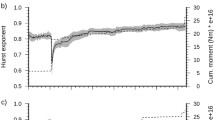Abstract
The earthquake motion phase (EMP) is decomposed into linear delay and fluctuation parts. In this paper, the peculiar stochastic characteristics of the fluctuation part of the phase (FPP) are discussed. First, we show that the FPP has self-afSne similarity and should be expressed as a fractal stochastic process by using several observed earthquake motion time histories, as well as the FPP has a long term memory in the frequency domain. Moreover, the possibility of simulating FPP using the simple fractional Brownian motion (fBm) is discussed and conclude that this is not possible. To overcome this problem, we develop a new stochastic process, the modified fBm that is able to simulate a stochastically rigorous sample FPP. This newly developed algorithm represents the phase characteristics of the observed EMP well.
Similar content being viewed by others
References
Abdelrahman, A. A., Sato, T., Wan, C., and Wu, Z. (2019). “Definition of yield seismic coefficient spectrum considering the uncertainty of the earthquake motion phase.” Applied Sciences, Vol. 9, No. 11, p. 2254, DOI: 10.3390/app9112254.
Biagini, F., Hu, Y., Oksendal, B., and Zhang, T. (2008). Stochastic Calculus for Fractional Brownian Motion and Applications, Springer Science & Business Media, London, UK.
Boore, D. M. (2003). “Phase derivatives and simulation of strong ground motions.” Bulletin of the Seismological Society of America, Vol. 93, No. 3, pp. 1132–1143, DOI: 10.1785/0120020196.
Cohen, L. (1995). Time - Frequency analysis, Vol. 778, Prentice Hall, Upper Saddle River, NJ, USA.
Falconer, K. (2014). Fractal geometry: Mathematical foundations and applications. John Wiley and Sons, Hoboken, NJ, USA.
Izumi, M., Watanabe, T., and Katukura, H. (1980). “Interrelation of fault mechanisms, phase inclinations and nonstationarities of seismic waves.” Proc. 7th World Conference on Earthquake Engineering, Istanbul, Turkey, Vol. 1, pp. 89–96.
Katukura, H. (1978). “A study on the phase properties of seismic waves.” Proc. 5th Japan Earthquake Engineering Symposium, Japan Society of Civil Engineers, Shinjuku, Tokyo, Japan, pp. 209–216.
Katukura, K. (1983). “A fundamental study on the phase properties of seismic waves.” Journal of Structural and Construction Engineering, Transactions of AIJ, 327, pp. 20–27.
Mandelbrot, B. B. and Van, J. W (1968). “Fractional Brownian motions, fractional noises and applications.” SIAM Review, Vol. 10, No. 4, pp. 422–437, DOI: 10.2307/2027184.
Meyer, Y. (1992). Wavelets and operators (Vol. 1), Cambridge University Press, Cambridge, UK.
Murono, Y, Sato, T., and Murakami, M. (2002). “Modeling of phase spectra for near-fault earthquake motions.” Proc. of 12th European Conf. on Earthquake Eng., Paris, France.
Nigam, N. C. (1982). “Phase properties of a class of random processes.” Earthquake Engineering and Structural Dynamics, Vol. 10, No. 5, pp. 711–717, DOI: 10.1002/eqe.4290100508.
Ohsaki, Y. (1979). “On the significance of phase content in earthquake ground motions.” Earthquake Engineering and Structural Dynamics, Vol. 7, No. 5, pp. 427–439, DOI: 10.1002/eqe.4290070504.
Papoulis, A. (1962). The Fourier integral and its applications. McGraw-Hill, New York, NY, USA.
Peng, Y. and Li, J. (2014). “Stochastic modeling for starting-time of phase evolution of random seismic ground motions.” Theoretical and Applied Mechanics Letters, Vol. 4, No. 1, p. 013009, DOI: 10.1063/2.1401309.
Sato, T., Murono, Y., and Nishimura, A. (2002). “Phase spectrum modeling to simulate design earthquake motion.” Journal of Natural Disaster Science, Vol. 24, No. 2, pp. 91–100.
Satoh, T., Uetake, T., and Sugawara, Y. (1996). “A study on envelope characteristics of strong motions in a period range of 1 to 15 seconds by using group delay time.” Proc. 11th World Conference on Earthquake Engineering, WCEE, Acapulco, Mexico.
Tanaka, K. and Sato, T. (2017). “Evaluation of inhomogeneous structures in seismic propagation path in Japan based on the fractal characteristic of observed earthquake motion phase.” Proc. 16th World Conference on Earthquake Engineering, WCEE, Acapulco, Mexico, Paper No. 1420.
Waezi, Z. and Rofooei, F. R. (2017). “Stochastic non-stationary model for ground motion simulation based on higher-order crossing of linear time variant systems.” Journal of Earthquake Engineering, Vol. 21, No. 1, pp. 123–150, DOI: 10.1080/13632469.2016.1149894.
Yang, D. and Zhang, C. (2013). “Fractal characterization and frequency properties of near-fault ground motions.” Earthquake Engineering and Engineering Vibration, Vol. 2, No. 4, pp. 503–518, DOI: 10.1007/s11803-013-0192-y.
Yang, D., Zhang, C., and Liu, Y. (2015). “Multifractal characteristic analysis of near-fault earthquake ground motions.” Soil Dynamics and Earthquake Engineering, Vol. 72, pp. 12–23, DOI: 10.1016/ j.soildyn.2015.01.020.
Zhang, C., Sato, T., and Lu, L. Y. (2011). “A phase model of earthquake motions based on stochastic differential equation.” KSCE Journal of Civil Engineering, KSCE, Vol. 15, No. 1, pp. 161–166, DOI: 10.1007/sl2205-011-1074-3.
Acknowledgements
The authors would like to acknowledge Japan Meteorological Agency and National Research for Earth and Disaster Resilience, as well as the Peer NGA Strong Motion Database, to provide valuable observed earthquake records. We also acknowledge the supports from JSPS, Grant-in-Aid for Scientific Research #18K04334, the National Natural Science Foundation of China (No.51578140) and the Project Funded by the Priority Academic Program Development of Jiangsu Higher Education Institutions (PAPD, No. CE02).
Author information
Authors and Affiliations
Corresponding author
Rights and permissions
About this article
Cite this article
Abdelrahman, A.A., Sato, T., Wan, C. et al. Simulation of Earthquake Motion Phase considering Its Fractal and Auto-covariance Features. KSCE J Civ Eng 23, 4102–4112 (2019). https://doi.org/10.1007/s12205-019-0348-z
Received:
Accepted:
Published:
Issue Date:
DOI: https://doi.org/10.1007/s12205-019-0348-z




